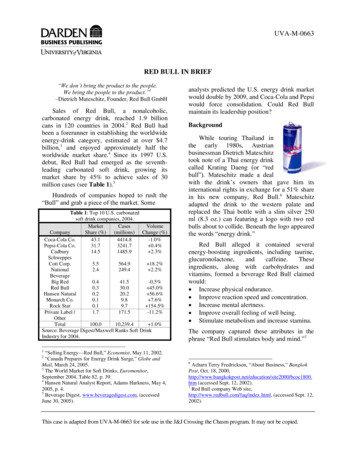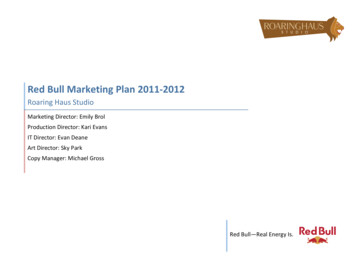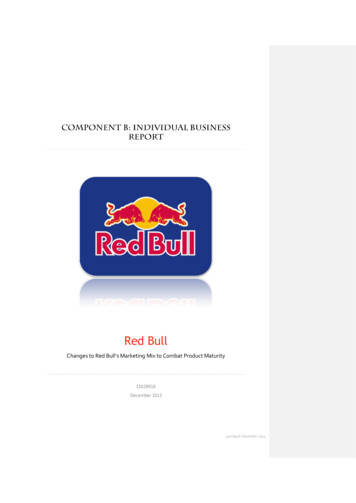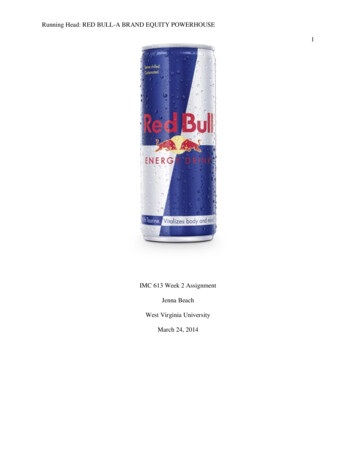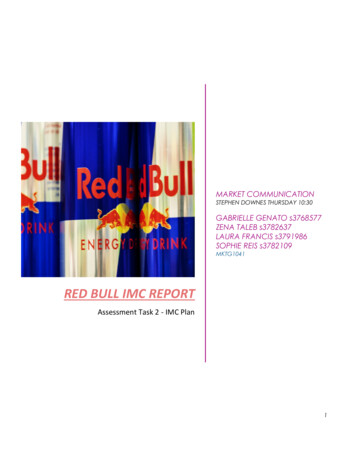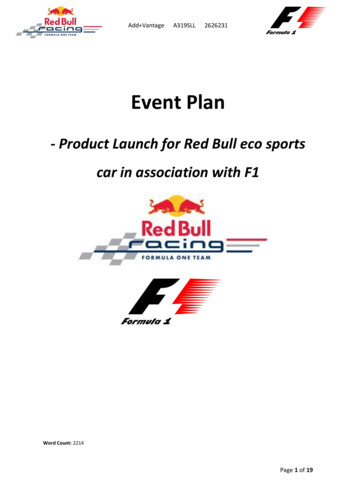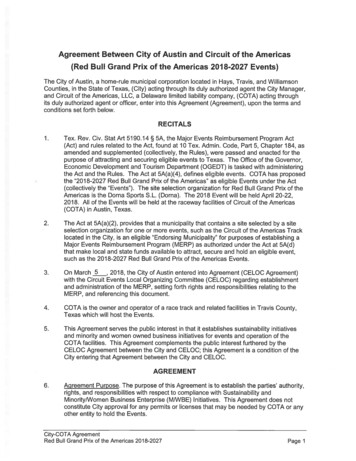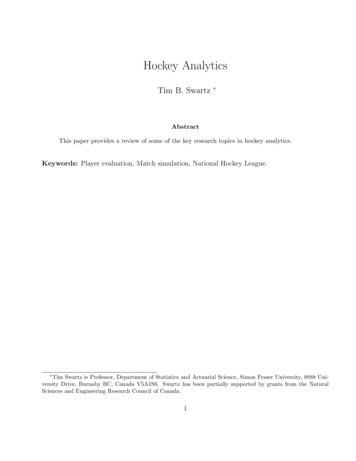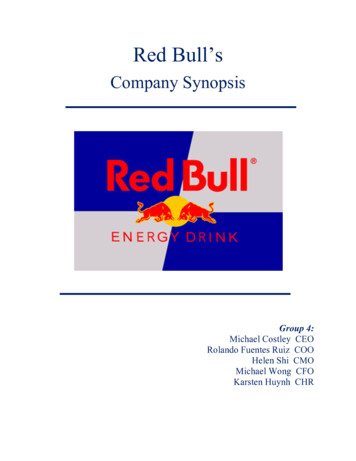
Transcription
Red Bull’sCompany SynopsisGroup 4:Michael Costley CEORolando Fuentes Ruiz COOHelen Shi CMOMichael Wong CFOKarsten Huynh CHR
IntroductionRed Bull, headquartered in Fuschl am see, Austria, manufactures energy drinks which aredescribed as “functional beverages providing various benefits, especially in times of increasedperformance” (Red Bull, 2013). The product claims to improve concentration, alertness and mostimportantly reduces the feeling of tiredness and fatigue. As of today, over 35 billion cans of Red Bullhave been sold in 165 countries throughout the world.Currently employing over 8,966 employees, Red Bull continues to see incredible companygrowth recording a 15.9% increase in 2012 (Red Bull, 2013). Red Bull also saw profits increase by40% in 2012 to 311 million from the financial year of 2011.Brief HistoryIn the Mid 1980’s Dietrich Mateschitz developed the recipe for Red Bull and formed thecompany Red Bull GmbH. Originally Red Bull was based on a Thai drink, Krating Daeng, whichwas created by Chaleo Yoovidhya (Red Bull, 2013). Mateschitz then partnered with Yoovidhya andreformulated the drink to Western palettes. Red Bull was first sold in its home market of Austria onApril 1st, 1987 and with this launch, Red Bull created a totally new “energy beverage” categorywithin the consumer beverage marketplace. Since then Red Bull continues to succeed with theirlimited product line and has recently launched new variations of the drink including differentflavours.1
Company GoalsRed Bull is dedicated to upholding the highest industry standards, while maintaining theirleadership position in the energy drinks category and delivering superior customer service in a highlyefficient and profitable manner. Red Bull’s desire to maintain their leadership position is reflected intheir mission statement “To spread our wings over the world” (Red Bull, 2013), as they continue tofocus on global expansion.International ExpansionRed Bull aims to strengthen its global position by focusing on their presence in Asia. RedBull has been successful in the past with its aggressive international expansion, and plans on using asimilar strategy to enter the Asian marketplace (Euromonitor, 2013). India is home to the highestnumber of 20-24 year-olds at 98 million, followed by China with 82 million and Indonesia with 21million. Since Red Bull's prime consumers are in their 20s the large youth population in these Asiancountries makes them an attractive market with large potential growth (Euromonitor, 2013).CurrentSituationProductsRed Bull has expanded their product line from the original Red Bull Energy Drink to RedBull Sugarfree, Total Zero, Energy Shot, and most recently, Red Bull Editions. Red Bull Editions istheir line of fruit flavoured drinks which include cranberry, lime, and blueberry. Red Bull productscontinue to gain popularity with an increase in product sales of 12.8% in 2012, resulting in 5.226billion cans sold worldwide (Red Bull, 2013). The key ingredients in Red Bull are caffeine, B-Group2
vitamins, sucrose, glucose, taurine, and Alpine spring water. With ingredients like taurine andcaffeine and the proliferation of energy drink consumption, Red Bull and the entire energy drinkindustry have come under scrutiny due to health concerns. As a result, new regulations on the sale ofenergy drinks are an ongoing concern for companies like Red Bull. Red Bull’s product line has alsowidened to include merchandise that is adorned with the company name such as hoodies, hats andshirts, due to their involvement in sponsoring athletes and events.Market ShareBy creating a product that had never been seen before, Red Bull has made their namesynonymous with the word energy drink. With Red Bull products sold in 165 countries, the companyholds an estimated global market share of 43% as of 2012 (MarketLine, 2012). This statistic becomeseven more impressive when you consider that their closest competitor, Monster Energy Drink, onlyholds an estimated 16% market share (MarketLine, 2012). This market share and brand recognitionhas allowed Red Bull to hold their ground and fend off larger beverage companies like Coca-Colaand PepsiCo. Even with such a dominant position in the energy drink market, Red Bull continues togrow. Figure 1 indicates the significant position Red Bull has over all other top competitors in theenergy drink market.FIGURE 1: Market share for the top energy drink companies for 2011* (MarketLine, 2012)3
Financial PerformanceIn 2011, Red Bull had sales of 2.93 and made 3.06 billion in operating revenue. This led toprofits of 402.4 million an increase of 35% from 2010. With 1.15 billion in current assets and 220.5 million in current liabilities, this results in an impressive current ratio of 5.22. Table 1 belowgoes into further detail on the financial performance of the company since 2007.TABLE 1: Red Bull GmbH Financial Summaryth USD31 Dec201131 Dec201031 Dec200931 Dec200831 Dec2007Total 29,7002,776,2852,854,004Cash & CashEquivalent383,59012910,2813635Net Income402,390298,797177,368181,971345,273*(Mint Global, 2013)Current StrategyThe high sales volume of Red Bull is largely dependent on their extensive and wellrecognized marketing strategies. The brand continues to be successful by pushing boundaries andimplementing campaigns that are unique and impactful.4
Social Media UseWith over 36 million “likes” on their Facebook fan page, Red Bull is one of the Top 10 mostliked corporations on Facebook. Even though they generate multiple updates per day, it is a rare sightto discover a post that is dedicated to its products. Rather, Red Bull’s corporate strategy is to focuson promoting the athletes and events that they sponsor. This reinforces the notion of Red Bull being alifestyle choice rather than just an energy drink. Further, unlike other brands, Red Bull does notrespond to user comments on Facebook and only replies to between 10 and 40 tweets per day, whichpromotes an elusive dimension to the brand (Moth, 2013).Publicity StuntsAlthough publicity stunts are nothing new in the market, the extremity of Red Bull stuntshave garnered viral attention and unparalleled publicity. The Red Bull Stratos event in October 2012was an ambitious stunt that funded Felix Baumgartner’s record-setting jump from the stratosphere.As the sponsor, it was a testament to Red Bull’s edgy brand through association with extreme eventsand their willingness to take risks. This stunt generated a media storm, with over 7.3 million liveviewers on YouTube, and half the worldwide Twitter trends being connected to the event(McNaughton, 2012). By capitalizing on these public opportunities, Red Bull has been able toeffectively increase its brand awareness through word of mouth.Sporting Events and AcquisitionsUnlike other soft drink companies who only sponsor events, Red Bull also implements aninnovative strategy where they develop and run a wide range of extreme sporting events themselves.This added involvement in the events provide Red Bull with added control and flexibility, serving acompetitive advantage. By actually purchasing the teams and relevant assets such as stadiums and5
technical equipment, Red Bull aims to keep these teams in the long-run in hopes of achieving futuresuccess. Examples include Red Bull’s Formula 1 racing team, which went on to be one of the bestfunded teams, and soccer teams which helped garner a larger mainstream audience (MarketLine,2012). These investments attract goodwill from sports fans, and supporters who are more likely to beinfluenced by brand recognition when selecting energy drinks.EnvironmentEconomic DynamicsSales in the “functional water” industry have been significantly impacted by the ongoingeconomic crises globally. However, the energy drink sector has proven most resilient andoutperformed other industry categories. It appears that consumers are cutting back on how manybeverages they consume but maintain their habits in energy drink consumption.The growing and lucrative energy drink market has attracted large competitors, namely TheCoca Cola Company and PepsiCo, to start offering their own products in the segment. However,despite these competitors dominance in other beverage segments, Red Bull has been able to maintainmarket leadership in the dynamic energy drink industry. (Euromonitor International, 2012)Legal and Political PressuresRed Bull manufactures and distributes all of it’s products from it’s only factory in Austria(Euromonitor International, 2012). However, by manufacturing all products in one central hub, RedBull is more susceptible to tax laws, tariffs, and high costs of distribution compared to competitorswhom have multiple worldwide facilities. Their current differentiation strategy has allowed Red Bull6
to market and sell their products at a premium which is absolutely necessary as they incur greatercosts relative to competitors. Currently, Red Bull is building a new facility in Brazil which isexpected to service the America’s and reduce these costs to make Red Bull more cost efficient(Russell, 2012).The nature of Red Bull’s dominant product offering is a source of political and legal issues.France, Denmark and Norway had at one point banned Red Bull products because of some concernsover the ingredients being used; these have all been lifted(FriedlNews,2013)(EuromonitorInternational, 2012). Additionally the high caffeine levels in Red Bull leave Red Bull vulnerable toregulatory controls. This issue is further amplified as Red Bull’s relies solely on energy drinkproducts.The United States, one of Red Bull’s key markets, has started to raise concerns over energydrink products as well. The city of Chicago is one area that is considering banning the sale of energydrink products to all consumers (Radar Staff, 2013). This is in light of increasing hospitalization dueto the consumption of energy drinks throughout the United States (The Associated Press, 2013). Thenegative press is without a doubt becoming a matter of great concern for the sector as a whole.Strategic ChallengesMaintaining Market Leadership in a Growing Competitive MarketAccording to a global study in 2011, Red Bull is leading the energy drinks market with amarket share containing 43% of the world’s value, and 21.5% of the world’s consumption (Passport,7
2012). Meanwhile, Hansen Natural Corp, Red Bull’s leading competitor only retains 16% and 14%of the world’s value and sales respectively (Passport, 2012). However, Red Bull’s comfortable leadin the energy drink market is likely to dwindle due to the two soft drink powerhouses, Coca-Cola andPepsiCo, recently targeting the energy drink market. Specifically Coca-Cola has formed partnershipswith Hansen Natural Corp, and PepsiCo has formed partnerships with Rockstar Energy. In order tomaintain its dominance in the energy drink market it is crucial that Red Bull increases their salesvolume and maintains its edgy brand image.Competitive PricingManufacturing only from a single Australian site, Red Bull was selling its product at apremium (Passport, 2012). Often priced twice as high as their leading substitutes, sports drinks andfunctional bottled water, Red Bull’s premium pricing has hindered their success in targeting a largerconsumer base. In addition, Red Bull’s premium pricing has become even less justified due to energydrinks becoming more analogous and enforces the notion of lowering prices to appeal to more pricesensitive consumers. In order to lower prices and increase sales volumes, it is important for Red Bullto consider constructing more manufacturing plants at strategic locations such as Asia, and that itensures the success of the new manufacturing plant in Brazil. However, the loss of a premium priceand a larger consumer base may have detrimental effects on Red Bull’s current edgy brand image.Maintaining an Edgy Brand ImageRed Bull’s current success and global presence is due to its brand image. Spending upwardsto 40% of its total sales on advertising, Red Bull has effectively advertised its brand as being edgyand “cool” to younger audiences through a wide range of activities from clothing lines to sport events(Passport, 2012). However, as Red Bull attempts to widen its marketed audience through competitive8
pricing, it may have adverse effects on its edgy brand image. This is due to the fact that Red Bullmay become viewed as being “uncool” and common place. Fortunately, Red Bull’s growing presencein the nightclub scene may help Red Bull remain relevant as an edgy brand among its core audience.Expanding in the Soft Drink IndustryThe soft drink industry includes the energy drinks segment and is lead by Coca-Cola andPepsiCo. Ranked seventh in terms of world value, and unranked in volume sales, it is unlikely thatRed Bull will be able to break into the top five of soft drink companies unless it expands its portfolio(Passport, 2012). In addition to expanding the amount of products it has to offer, it is important thatRed Bull effectively manages its marketing among its products. The recent abysmal performance ofRed Bull’s new product Red Bull Cola in contrast to its current main product, emphasizes the need toeffectively allocate resources. In addition, Red Bull’s highly caffeinated drinks may put its product atrisk of regulation and inhibit its global growth.9
ReferencesEuromonitor International. (2012, March 9). Red Bull GmbH in Soft Drinks (World). Retrieved fromEuromonitor: http://www.portal.euromonitor.com/Euromonitor International. (2012, March 9). Red Bull plans Asian Expansion. Retrieved fromEuromonitor: http://www.portal.euromonitor.com/FriedlNews. (2013, March 15). Red Bull Sells More Than 5bn Cans Worldwide. Retrieved fromFriedlNews: more-than-5bn-cansworldwideMarketLine. (
technical equipment, Red Bull aims to keep these teams in the long-run in hopes of achieving future success. Examples include Red Bull’s Formula 1 racing team, which went on to be one of the best funded teams, and soccer teams which helped garner a larger mainstream audience (MarketLine, 2012). These investments attract goodwill from sports fans, and supporters who are more likely to be
